Humidity Distribution in High-Occupancy Indoor Micro-Climates
Abstract
1. Introduction
1.1. Background
1.2. Current Research on the Spatio-Temporal Distribution of Air in Interior Micro-Climates
1.3. Current Literature on Manikin Modeling for Use in Simulations
1.4. Scope and Paper Outline
2. Methodology
2.1. Experimental Setup
2.2. CFD Model
- Y is the local mass fraction of the species;
- is the diffusion flux of the species;
- R is the net rate of production of species by chemical reaction (0 in this case);
- S is the user defined source of the species (in ).
- , , , , and are model constants;
- , , and are damping functions;
- is the dynamic viscosity;
- D and E are expressions which are only active close to solid walls and make it possible to solve k and down to the viscous sublayer. The expressions are functions of the distance from the solid walls.
3. Humidity Distribution
3.1. Simulation Results
- is the mass of water above each occupant;
- H is the total water vapor mass fraction on top of the person, calculated using the CFD program;
- is the average density of air on top of each person, calculated using the CFD program.
- S is the surface of the interrogation volume;
- is the velocity vector;
- is the normal to the surface of the cuboid.
3.2. Discussion
4. Conclusions
- Contrary to the general consensus that humidity distribution inside an interior living space is practically uniform, this study has shown that there may be cases where the spatio-temporal distribution of humidity varies considerably inside a room, specifically as shown in this case of high humidity.
- The case of a high-humidity source inside a test chamber was analyzed through the simulation of a high-density population inside the room. The authors determined that different locations were effected by different amounts of humidity over a two-hour period. A 31% difference was calculated between the locations having the highest and lowest masses of water in their surroundings.
- It was also determined that, as expected, the distribution of humidity was closely related to the path of air flow inside the room.
- For this specific case, it was determined that the people seated furthest from the inlet and closest to the outlet would have the least amount of water vapor above them.
Author Contributions
Funding
Institutional Review Board Statement
Informed Consent Statement
Data Availability Statement
Acknowledgments
Conflicts of Interest
Abbreviations
| CFD | Computational Fluid Dynamics |
| GCI | Grid Convergence Index |
| LRNM | Low Reynolds Number k- model |
| NASA | The National Aeronautics and Space Administration |
| PMV | Predicted Mean Vote |
| PPD | Predicted Percentage of Dissatisfied |
| RH | Relative Humidity |
| SET | Standard Effective Temperature |
| TS | Test Subject |
| TUI | Text User Interface |
| Specific Humidity |
References
- Kaynakli, O.; Kilic, M. Investigation of indoor thermal comfort under transient conditions. Build. Environ. 2005, 40, 165–174. [Google Scholar] [CrossRef]
- Fanger, P.O. Thermal comfort: Analysis and applications in environmental engineering: Fanger, P.O. Danish Technical Press, Copenhagen, Denmark, 1970, 244 pp.: Abstr. in World Textile Abstracts. Appl. Ergon. 1972, 3, 181. [Google Scholar] [CrossRef]
- Chiang, W.H.; Wang, C.Y.; Huang, J.S. Evaluation of cooling ceiling and mechanical ventilation systems on thermal comfort using CFD study in an office for subtropical region. Build. Environ. 2012, 48, 113–127. [Google Scholar] [CrossRef]
- Ciuha, U.; Mekjavic, I.B. Regional thermal comfort zone in males and females. Physiol. Behav. 2016, 161, 123–129. [Google Scholar] [CrossRef]
- Liu, W.; Huangfu, H.; Xiong, J.; Deng, Q. Feedback effect of human physical and psychological adaption on time period of thermal adaption in naturally ventilated building. Build. Environ. 2014, 76, 1–9. [Google Scholar] [CrossRef]
- Requena-Ruiz, I. Thermal comfort in twentieth-century architectural heritage: Two houses of Le Corbusier and André Wogenscky. Front. Archit. Res. 2016, 5, 157–170. [Google Scholar] [CrossRef]
- Li, B.; Du, C.; Tan, M.; Liu, H.; Essah, E.; Yao, R. Studies of the impact of air humidity on human acceptable air temperatures in hot-humid environments. Energy Build. 2017, 158, 393–405. [Google Scholar] [CrossRef]
- Yu, B.H.; Seo, B.M.; Hong, S.H.; Yeon, S.; Lee, K.H. Influences of different operational configurations on combined effects of room air stratification and thermal decay in UFAD system. Energy Build. 2018, 176, 262–274. [Google Scholar] [CrossRef]
- Wiriyasart, S.; Naphon, P. Numerical study on air ventilation in the workshop room with multiple heat sources. Case Stud. Therm. Eng. 2019, 13, 100405. [Google Scholar] [CrossRef]
- Srivajana, W. Effects of Air Velocitv on Thermal Comfort in Hot and Humid Climates. Thammasat Int. J. Sci. Tech. 2003, 8, 45–54. [Google Scholar]
- Parsons, K. Human Thermal Environments the Effects of Hot, Moderate, and Cold Environments on Human Health, Comfort, and Performance, 3rd ed.; CRC Press: Boca Raton, FL, USA, 2014. [Google Scholar]
- Tanabe, S.; Kimura, K. Effects of air temperature, humidity, and air movement on thermal comfort under hot and humid conditions. ASHRAE Trans. 1994, 100, 953–969. [Google Scholar]
- Zhang, H.; Yoshino, H. Analysis of indoor humidity environment in Chinese residential buildings. Build. Environ. 2010, 45, 2132–2140. [Google Scholar] [CrossRef]
- Jin, L.; Zhang, Y.; Zhang, Z. Human responses to high humidity in elevated temperatures for people in hot-humid climates. Build. Environ. 2017, 114, 257–266. [Google Scholar] [CrossRef]
- Tsutsumi, H.; Tanabe, S.-i.; Harigaya, J.; Iguchi, Y.; Nakamura, G. Effect of humidity on human comfort and productivity after step changes from warm and humid environment. Build. Environ. 2007, 42, 4034–4042. [Google Scholar] [CrossRef]
- Djamila, H.; Chu, C.M.; Kumaresan, S. Effect of Humidity on Thermal Comfort in the Humid Tropics. J. Build. Constr. Plan. Res. 2014, 2, 109. [Google Scholar] [CrossRef]
- Saber, E.; Mast, M.; Tham, K.W.; Leibundgut, H. Numerical Modelling of an Indoor Space Conditioned with Low Exergy Cooling Technologies in the Tropics. In Proceedings of the 13th International Conference on Indoor Air Quality and Climate, Hong Kong, China, 7–12 July 2014. [Google Scholar] [CrossRef]
- Mortensen, L.H.; Woloszyn, M.; Rode, C.; Peuhkuri, R. Investigation of Microclimate by CFD Modeling of Moisture Interactions between Air and Constructions. J. Build. Phys. 2007, 30, 279–315. [Google Scholar] [CrossRef]
- Wurtz, E.; Haghighat, F.; Mora, L.; Cordeiro Mendonça, K.; Maalouf, C.; ZHAO, H.; Bourdoukan, P. An integrated zonal model to predict transient indoor humidity distribution. ASHRAE Trans. 2006, 112, 175–186. [Google Scholar]
- Huang, H.; Kato, S.; Hu, R.; Ishida, Y. Development of new indices to assess the contribution of moisture sources to indoor humidity and application to optimization design: Proposal of CRI(H) and a transient simulation for the prediction of indoor humidity. Build. Environ. 2011, 46, 1817–1826. [Google Scholar] [CrossRef]
- Butera, F.M. Chapter 3—Principles of thermal comfort. Renew. Sustain. Energy Rev. 1998, 2, 39–66. [Google Scholar] [CrossRef]
- Lefevre, J. Chaleur Animale et Energetigue; Masson: Paris, France, 1911. [Google Scholar]
- Burton, A.C. The Application of the Theory of Heat Flow to the Study of Energy Metabolism: Five Figures. J. Nutr. 1934, 7, 497–533. [Google Scholar] [CrossRef]
- Tanabe, S.; Kobayashi, K.; Nakano, J.; Ozeki, Y.; Konishi, M. Evaluation of thermal comfort using combined multi-node thermoregulation (65MN) and radiation models and computational fluid dynamics (CFD). Energy Build. 2002, 34, 637–646. [Google Scholar] [CrossRef]
- Fiala, D.; Lomas, K.J.; Stohrer, M. A computer model of human thermoregulation for a wide range of environmental conditions: The passive system. J. Appl. Physiol. 1999, 87, 1957–1972. [Google Scholar] [CrossRef]
- Kingma, B.R.M.; Schellen, L.; Frijns, A.J.H.; van Marken Lichtenbelt, W.D. Thermal sensation: A mathematical model based on neurophysiology. Indoor Air 2012, 22, 253–262. [Google Scholar] [CrossRef]
- Dubois, D.; Dubois, E.F. A formula to estimate the approximate area if height and weight be known. Arch. Intern. Med. (Chic) 1916, 17, 863–871. [Google Scholar] [CrossRef]
- Katić, K.; Li, R.; Zeiler, W. Thermophysiological models and their applications: A review. Build. Environ. 2016, 106, 286–300. [Google Scholar] [CrossRef]
- Gagge, A.P. An Effective Temperature Scale Based on a Simple Model of Human Physiological Regulatory Response. ASHRAE Trans. 1971, 77, 247–262. [Google Scholar]
- Stolwijk, J. A Mathematical Model of Physiological Temperature Regulation in Man; Number v. 1855 in NASA Contractor Report; National Aeronautics and Space Administration: Washington, DC, USA, 1971.
- Fiala, D.; Havenith, G.; Bröde, P.; Kampmann, B.; Jendritzky, G. UTCI-Fiala multi-node model of human heat transfer and temperature regulation. Int. J. Biometeorol. 2012, 56, 429–441. [Google Scholar] [CrossRef]
- Cook, M.; Cropper, P.; Fiala, D.; Yousaf, R.; Bolineni, S.; van Treeck, C. Coupled CFD and Thermal Comfort Modeling in Cross-Ventilated Classrooms. ASHRAE Trans. 2013, 119, 1–8. [Google Scholar]
- Dixit, A.; Gade, U. A case study on human bio-heat transfer and thermal comfort within CFD. Build. Environ. 2015, 94, 122–130. [Google Scholar] [CrossRef]
- Onset. HOBO UX100-003 Data Logger. Original Datasheet from Onset. Available online: www.onsetcomp.com/datasheet/UX100-003 (accessed on 15 March 2017).
- Lascar-Electronics. EL-WiFi-21CFR-TH. Original Datasheet from Lascar Electronics. Available online: https://docs-emea.rs-online.com/webdocs/15e9/0900766b815e9e66.pdf (accessed on 22 August 2016).
- Kimo-Instruments. MP 210. Original Datasheet from Kimo Instruments. Available online: http://kimo-instruments.com/sites/kimo/{\@@par}les/2017-09/FTang_portable_MP210-25-08-170.pdf (accessed on 25 August 2017).
- Kimo-Instruments. SFC900GN. Original Datasheet from Kimo Instruments. Available online: www.kimo.it/wp-content/uploads/2016/10/24782.pdf (accessed on 24 October 2016).
- ISO 9972. Thermal Performance of Buildings—Determination of Air Permeability of Buildings—Fan Pressurization Method; Standard; International Organization for Standardization: Geneva, Switzerland, 2015. [Google Scholar]
- ASTM E779-19. Standard Test Method for Determining Air Leakage Rate by Fan Pressurization; Standard; ASTM International: West Conshohocken, PA, USA, 2019. [Google Scholar] [CrossRef]
- ASTM E741-11. Standard Test Method for Determining Air Change in a Single Zone by Means of a Tracer Gas Dilution; Standard; ASTM International: West Conshohocken, PA, USA, 2017. [Google Scholar] [CrossRef]
- Sherman, M.H. Comparison of Methods for the Measurement of Air Change Rates and Interzonal Airflows in Two Test Residences. In Air Change Rate and Airtightness in Buildings: Symposium: Papers; ASTM: Philadelphia, PA, USA, 1990; pp. 104–113. [Google Scholar]
- Roulet, C.A.; Foradini, F. Simple and Cheap Air Change Rate Measurement Using CO2 Concentration Decays. Int. J. Vent. 2002, 1, 39–44. [Google Scholar] [CrossRef]
- ASHRAE. Chapter 16—Ventilation and Infiltration. In 2017 ASHRAE Handbook—Fundamentals (SI Edition); ASHRAE: Atlanta, GA, USA, 2017. [Google Scholar]
- Bonello, M.; Micallef, D.; Borg, S. Flat Bed Desiccant Dehumidification: A predictive model for desiccant transient characterisation using a species transport model within CFD. J. Build. Eng. 2019, 23, 280–290. [Google Scholar] [CrossRef]
- ANSYS. 1994. Available online: ansys56manual.pdf (accessed on 24 December 2020).
- University of Malta. Overview_of_Albert; University of Malta: Msida, Malta, 2012. [Google Scholar]
- Yang, Z.; Shih, T. New time scale based k-epsilon model for near-wall turbulence. AIAA J. 1993, 31, 1191–1198. [Google Scholar] [CrossRef]
- Bonello, M.; Micallef, D.; Borg, S. Humidity micro-climate characterisation in indoor environments: A benchmark study. J. Build. Eng. 2020, 28, 101013. [Google Scholar] [CrossRef]
- Roache, P.J. Verification and Validation in Computational Science and Engineering; Hermosa Publishers: Socorro, NM, USA, 1998; pp. 107–141. [Google Scholar]
- Zielinski, J.; Przybylski, J. How much water is lost during breathing? Pneumonol. Alergol. Pol. 2012, 80, 339–342. [Google Scholar]
- ASHRAE. Chapter 5—Places of Assembly. In 2015 ASHRAE Handbook: Heating, Ventilating, and Air-Conditioning Applications, SI ed.; ASHRAE: Atlanta, GA, USA, 2015. [Google Scholar]
- Egorov, A.; Martuzzi, M.; Krzyzanowski, M.; Hänninen, O.; Haverinen-Shaughnessy, U.; Täubel, M.; Geiss, O.; Kephalopoulos, S.; Barrero, J.; Wendland, C.; et al. School Environment: Policies and Current Status; World Health Organization: Geneva, Switzerland, 2015. [Google Scholar]
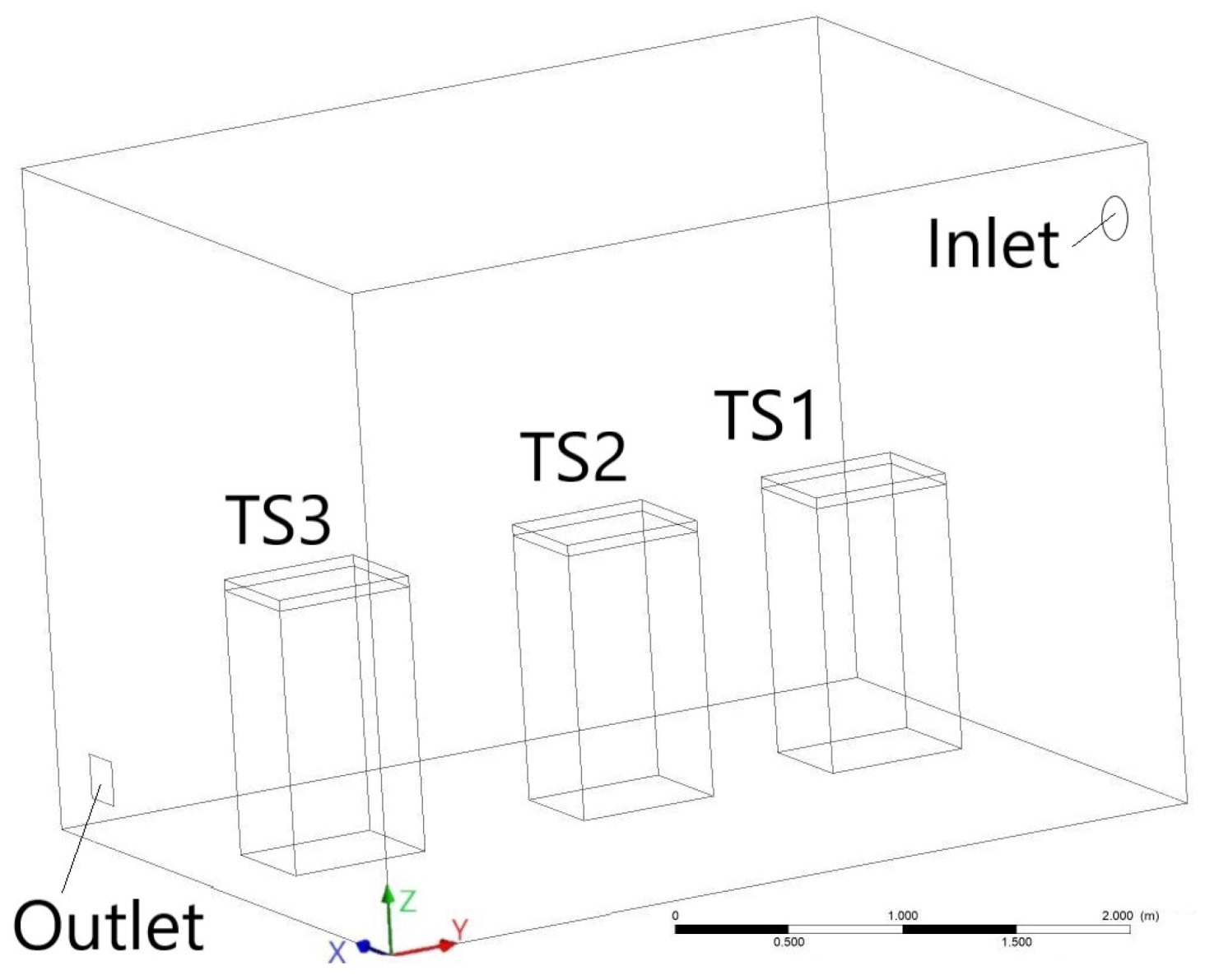

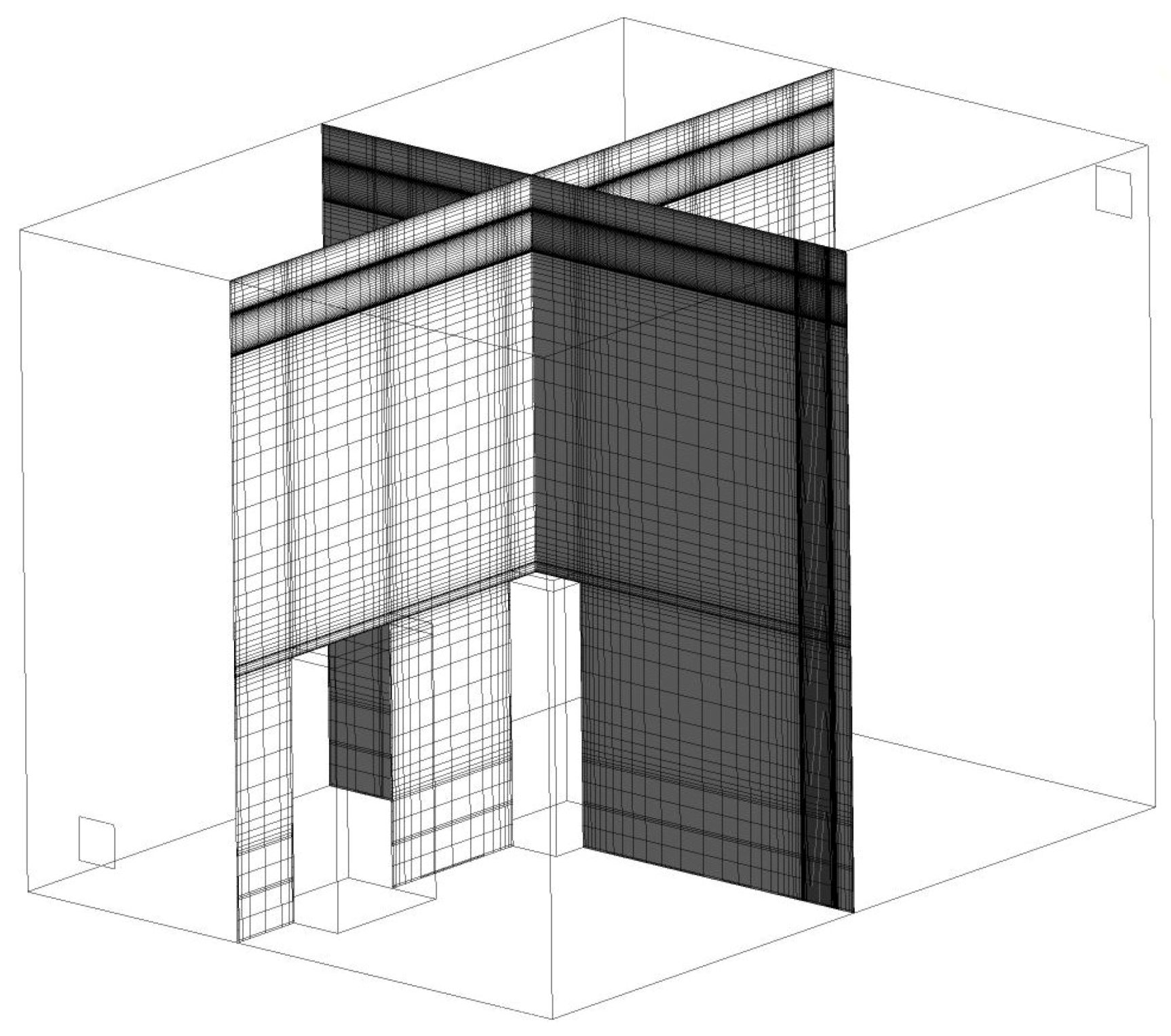
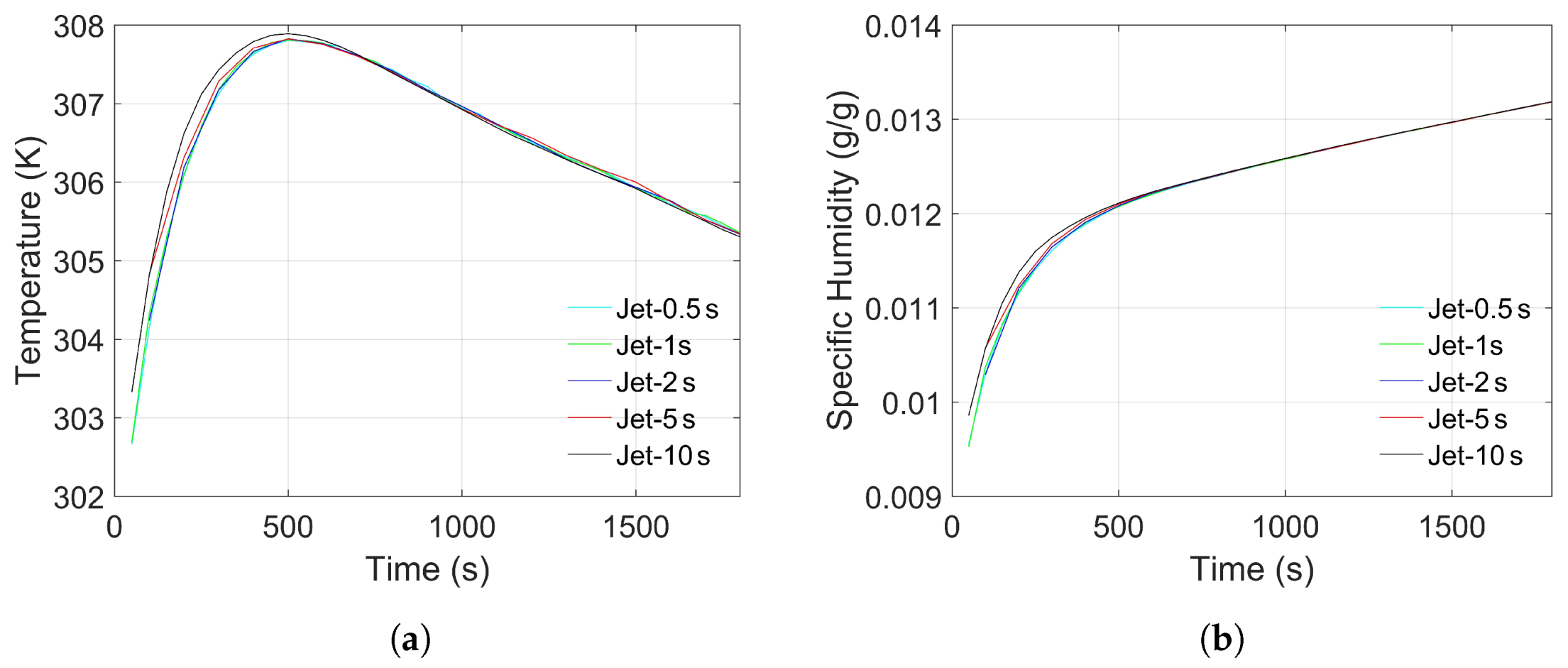
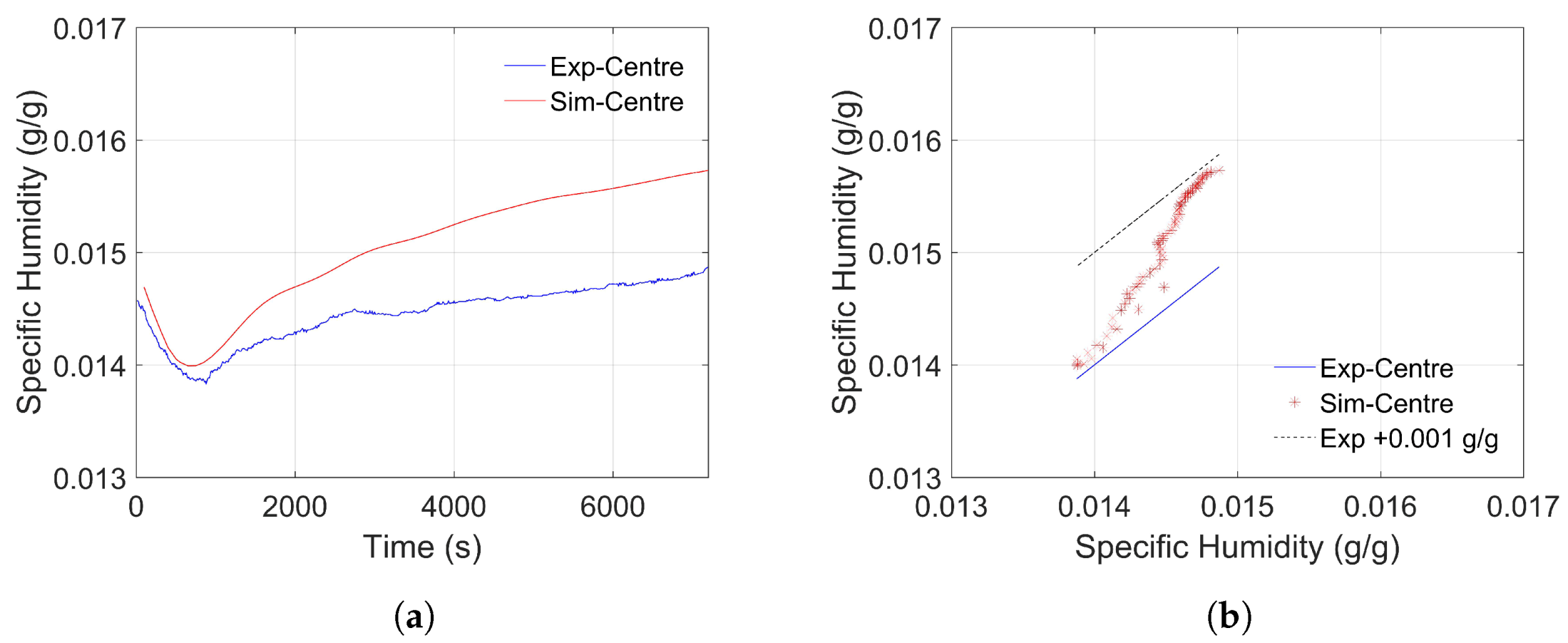


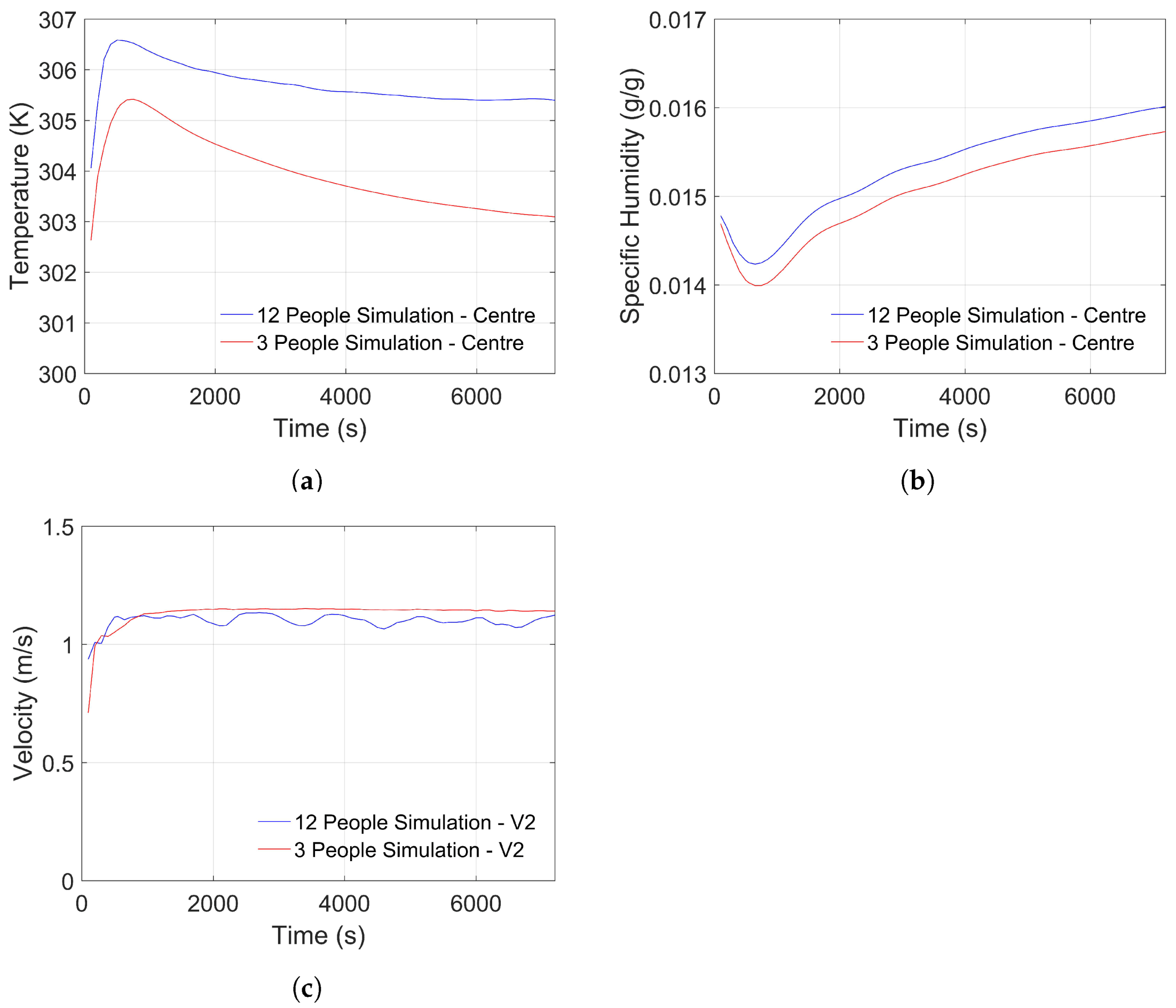
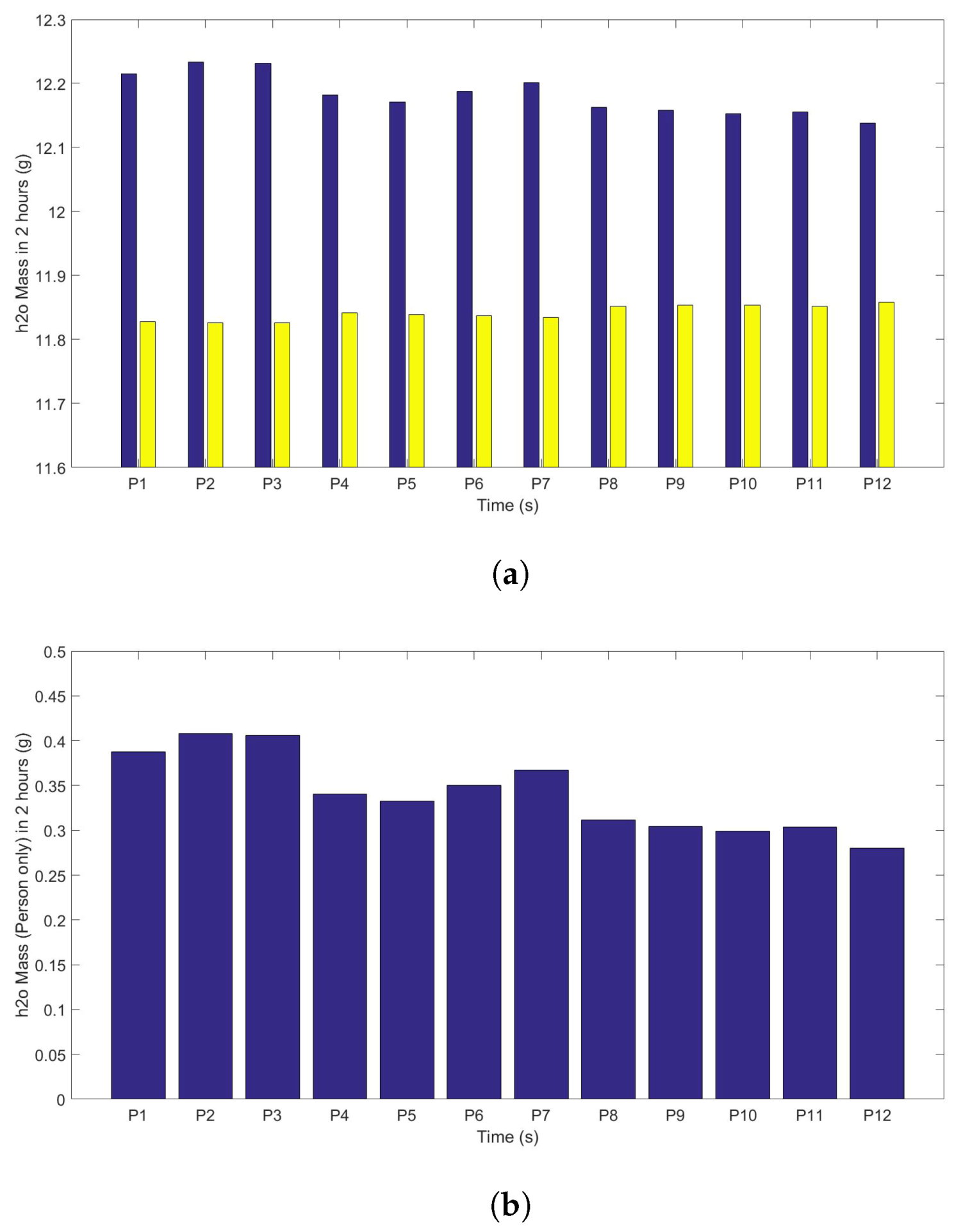
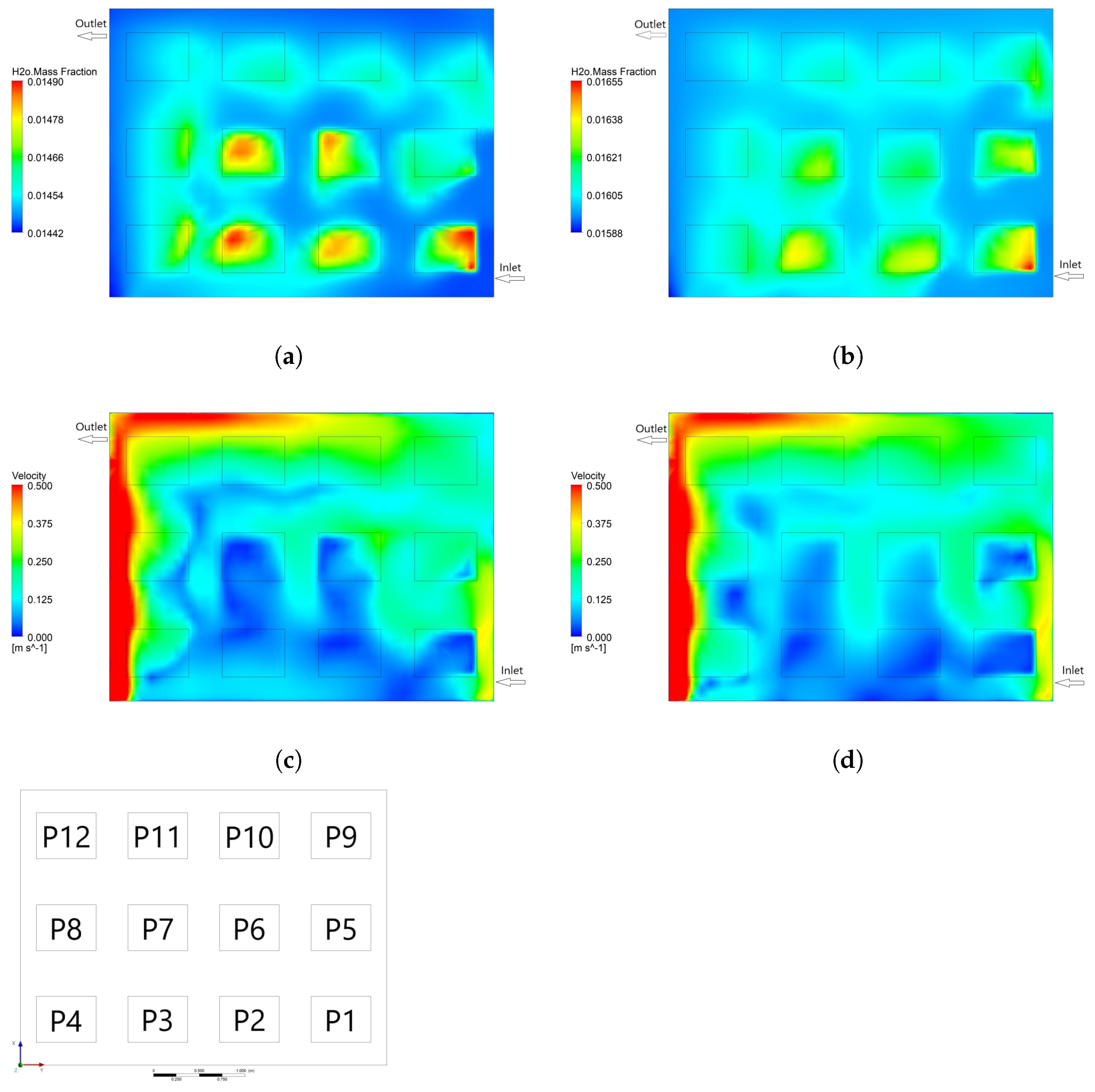
| Gender | Age | Height | Weight | BMI | Clothing | Centre | ||||
|---|---|---|---|---|---|---|---|---|---|---|
| Standing | Seated | Insulation | Coordinate | |||||||
| m | m | kg | clo | x | y | z | ||||
| TS1 | Female | 32 | 1.69 | 1.21 | 67.5 | 23.6 | 0.57 | 1.21 | 3.39 | 0 |
| TS2 | Male | 32 | 1.67 | 1.23 | 53 | 19 | 0.57 | 1.21 | 2.16 | 0 |
| TS3 | Male | 21 | 1.75 | 1.27 | 72 | 23.5 | 0.57 | 1.21 | 0.68 | 0 |
| Sensor | Name | Co-Ordinates | Type | Temperature | Relative Humidity | Logging | ||||
|---|---|---|---|---|---|---|---|---|---|---|
| x | y | z | Accuracy | Range | Accuracy | Range | Period | |||
| m | m | m | % | % | s | |||||
| 1 | Inlet | 0.20 | 3.99 | 2.75 | HOBO | ±0.21 | −20–70 | ±3.5 | 15–95 | 10 |
| 2 | Outlet | 2.61 | 0.01 | 0.44 | HOBO | ±0.21 | −20–70 | ±3.5 | 15–95 | 10 |
| 3 | Front | 1.71 | 0.43 | 1.93 | HOBO | ±0.21 | −20–70 | ±3.5 | 15–95 | 10 |
| 4 | Side | 2.29 | 2.33 | 1.45 | 21CFR | ±0.30 | −20–60 | ±2.0 | 0–100 | 60 |
| 5 | Jet | 0.27 | 2.14 | 2.56 | 21CFR | ±0.30 | −20–60 | ±2.0 | 0–100 | 60 |
| 6 | Centre | 1.52 | 2.20 | 2.44 | HOBO | ±0.21 | −20–70 | ±3.5 | 15–95 | 10 |
| 9 | Back | 1.83 | 3.40 | 1.73 | 21CFR | ±0.30 | −20–60 | ±2.0 | 0–100 | 60 |
| Sensor | Name | Co-Ordinates | Velocity | Logging | |||
|---|---|---|---|---|---|---|---|
| x | y | z | Accuracy | Range | Period | ||
| m | m | m | m s | min | |||
| 1 | V1 | 0.31 | 2.80 | 2.60 | ±3% ±0.03 m s | 0.15–30 | 5 |
| 2 | V2 | 0.31 | 1.10 | 2.63 | ±3% ±0.03 m s | 0.15–30 | 5 |
| Person | Mass of Water Vapour (in Grams) | ||
|---|---|---|---|
| Person and Micro-Climate | Micro-Climate Without Person | Person Only | |
| P1 | 12.2155 | 11.8279 | 0.3877 |
| P2 | 12.2337 | 11.8257 | 0.4080 |
| P3 | 12.2320 | 11.8257 | 0.4063 |
| P4 | 12.1823 | 11.8418 | 0.3406 |
| P5 | 12.1715 | 11.8390 | 0.3324 |
| P6 | 12.1872 | 11.8367 | 0.3505 |
| P7 | 12.2015 | 11.8340 | 0.3675 |
| P8 | 12.1629 | 11.8516 | 0.3114 |
| P9 | 12.1583 | 11.8538 | 0.3045 |
| P10 | 12.1528 | 11.8539 | 0.2989 |
| P11 | 12.1556 | 11.8516 | 0.3040 |
| P12 | 12.1383 | 11.8582 | 0.2800 |
Publisher’s Note: MDPI stays neutral with regard to jurisdictional claims in published maps and institutional affiliations. |
© 2021 by the authors. Licensee MDPI, Basel, Switzerland. This article is an open access article distributed under the terms and conditions of the Creative Commons Attribution (CC BY) license (http://creativecommons.org/licenses/by/4.0/).
Share and Cite
Bonello, M.; Micallef, D.; Borg, S.P. Humidity Distribution in High-Occupancy Indoor Micro-Climates. Energies 2021, 14, 681. https://doi.org/10.3390/en14030681
Bonello M, Micallef D, Borg SP. Humidity Distribution in High-Occupancy Indoor Micro-Climates. Energies. 2021; 14(3):681. https://doi.org/10.3390/en14030681
Chicago/Turabian StyleBonello, Matthew, Daniel Micallef, and Simon Paul Borg. 2021. "Humidity Distribution in High-Occupancy Indoor Micro-Climates" Energies 14, no. 3: 681. https://doi.org/10.3390/en14030681
APA StyleBonello, M., Micallef, D., & Borg, S. P. (2021). Humidity Distribution in High-Occupancy Indoor Micro-Climates. Energies, 14(3), 681. https://doi.org/10.3390/en14030681








